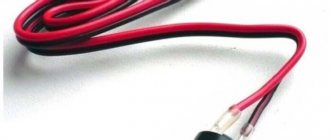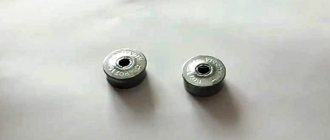Fishermen often go fishing overnight. In order to sit comfortably behind a fishing rod in a crowd of seven and even in complete darkness, the fishing rod is equipped with an electronic signaling device - a firefly. If you don’t have the time or desire to find a suitable firefly in the store, we offer a primitive method for making such a device suitable for feeder fishing.
- At the end of the publication there is a video of the author of this homemade product.
- – hot melt glue – hairpins;
- – LED bulbs; – 3 V batteries; - lighter; – heat-shrinkable tubes;
- - cocktail straws.
Craftsmen buy inventions from the best Chinese online store.
First, cut a piece approximately 3-4 cm long from the tube.
DIY electronics in a Chinese store.
Fill the piece of tube with hot glue.
We install the LED inside so that the contacts stick out 0.5 cm. We wait a while for the glue to harden.
The time has come when you need to insert the battery into the shrink material. The tube must match the battery. Cut off 2 centimeters.
Immerse the battery halfway up the tube. We heat the heat shrink, giving it the shape that can be seen in the second picture below.
We stuff the tube with the light bulb into the prepared heat shrink so that the leads coincide with the battery contacts.
We warm up the heat shrink, creating a tight fit around the light bulb with the tube. During this procedure, shake the tube to prevent it from sticking.
A situation may arise where the heat shrink cannot be further contracted. Then increase the diameter of the LED tube. This is where hot melt adhesive comes in handy. The tightness of the electrical connection is a must in this homemade bite alarm.
At the free end we connect a small piece of tube with glue. The firefly of an electronic device can be controlled by using a corrugated area.
- Now you can glue the hairpin.
The electronic bite alarm has been made. To use it during night fishing, you need to insert tubes with an LED on it into the tip of a fishing rod or other equipment so that the light bulb can light up. Using a crocodile clip, we fix the firefly at the end of the fishing rod and wait for a bite.
Source: https://izobreteniya.net/kak-sdelat-elektronnyiy-signalizator-poklevki-dlya-nochnoy-ryibalki/
The simplest bite alarms (principles of operation, manufacturing instructions):
Every fisherman has eyes, ears and hands to determine the bite. The mechanical signaling device is designed, due to its operating principle, to indicate the beginning of a bite through visual, acoustic or tactile contact.
Mechanical visual alarms
Nod. The simplest devices are the familiar float or the tip of a fishing rod (nod).
These types of alarms are familiar to everyone. Every fisherman knows how to make a float and nod himself, or which one to buy. Foil tube. Also, there are slightly different alarms, which are based on the principle of operation on the vibration of the fishing line. The simplest visual one is a foil tube.
- Take aluminum foil and roll it into a tube.
- Then we put the tube on the main fishing line.
- You need to thread the line between the reel and the first ring on the rod - the line will sag in this place.
As the bite begins, the sag of the line decreases, we understand that the fish has begun to grab the bait. Aluminum foil is good because it shimmers in the sun (its movement is clearly visible), and also rustles when bouncing.
Disadvantage - it is useless in windy conditions (reason is the lightness of the material).
Mechanical acoustic alarms
The right bell. Let's talk about a simple acoustic signaling device - these are bells. Our design is much better than store-bought bells, since the bell flies off the tackle during hooking and does not interfere with fishing.
- We buy a bell and remove everything that hangs on it.
- We are looking for a rubber hose about three centimeters in diameter. When searching, pay attention to the fact that its walls are thin.
- On the hose we measure a piece one and a half centimeters in length.
- Cut off the measured ring and see what shape it has. If it’s a circle, then we cut along one side anywhere, but if it’s an oval, then we make a cut on one of the elongated sides.
- Now we need two nuts and a bolt. The size of the bolt is such that it fits into the ear of the bell.
- Now you need to make a hole at one end of the cut rubber ring equal to the diameter of the bolt (it is better to drill at low speeds).
- We thread the bolt through the hole in the rubber ring (with the head inside the ring). You will get a hook made of a rubber ring with a bolt protruding from one side.
- We put a piece of thick fishing line a meter long on the bolt with a tightening loop.
- Tighten the loop.
- Now we put on the bell, press everything together and tighten it with a nut, then screw on the second nut to lock the first.
We have a bell with a rubber hook. We hang it on the fishing line closer to the tip of the rod. When hooking, the bell may fly off - in order not to lose it, we tie the free end of the fishing line on our structure to a peg in the ground.
This design is much better than the cheap bells that are sold in stores. Because the signaling device flies off the rod. You don't irritate yourself or nearby fishermen. And also you don’t scare away the fish.
Making your own visual bite alarms
A visual alarm helps the fisherman visually notice a fish bite. Eye alarms come in the form of a nod, float, firefly or foil tube.
Nod
The nod is a spring with a length of 10 to 15 cm. On one side, the spring is attached to the tip of the feeder, and on the other side there is a ring into which the fishing line is threaded. To assemble a feeder nod with your own hands, you will need a rigid steel wire or a ready-made spring element. The nod can be made movable. To do this, attach a rubber or plastic tube to the tip of the feeder. When changing the length of the tube, the rigidity of the nodding mechanism is adjusted.
Float
The float can be made from a thick piece of foam or purchased ready-made in the store. When creating, it is important to maintain the proportions of the weight of the feeder and the alarm, otherwise the float will either sink immediately or float on its side. During the process of assembling the tackle, a locking ring is attached to the fishing line, which helps to select and adjust the immersion depth of the feeder. It is best to make the ring tight so that the length of the fishing line is adjusted only when necessary.
We also recommend reading:
Budget spinning reels Riobi Exiya Features of crucian carp killer gear and how to make such equipment How to properly tie a jig to a fishing line Diagram of how to learn how to tie a hook to a fishing line
Electronic signaling devices
Having thought about the alarm and appreciating its advantages, I want more from it. A mechanical alarm requires mandatory control by the fisherman over its operation, that is, being near the fishing rods all the time. What if you want more? To go away for natural needs, cook food, just relax and stretch your legs, here an electronic alarm comes to the rescue, it is also called a swinger for fishing. It does not require constant presence near the rod and will indicate a bite with a visual (light) or sound signal. There are a sufficient number of types, types and models on sale.
Can be divided into types:
- visual
- sound
- combined
The principle of operation is just as simple - the fishing line passes through the slot, there is a small reel in the slot, and when it moves, a signal is triggered.
So, we described primitive mechanical alarms and briefly talked about factory-made electronic alarms, which are sold in stores. Now we’ll tell you how to make a more or less simple design of a mechanical signaling device, as well as how to assemble an electronic one yourself.
Design and manufacture of a simple side mechanical signaling device
We will need the following components:
- Latch fastener for PVC pipes (used for fastening to a wall, ceiling or floor, the pipe itself is snapped into it).
- Steel (elastic) wire 20 cm long and 0.8 - 1 mm in diameter.
- Nylon thread, waterproof glue, any paint for metal of a “poisonous-bright” color (paint can be bought in cans) or a self-adhesive film of a bright color.
- A rod or tube (guide) 8-10 cm long. The diameter of the tube is such that it fits tightly into the side hole for the PVC pipe holder.
Step-by-step instruction
Let's start assembling our alarm device.
- We make a hole at the end of the tube or rod according to the diameter of the wire.
- We bend the wire in an arc, measure 5 cm from one end and bend it 90 degrees outward from the inner bend of the arc.
- We thread the wire through the hole in the tube or rod. We will have a curved tip parallel to the guide.
- We coat the tip of the wire and the guide with glue and wrap it tightly with thread in several layers.
- We coat each layer with glue.
- Once it dries, you can either paint this place or open it with varnish (for example, for nails), as an option, put a heat-shrinkable tube over the gluing area and use a lighter to encircle it along the diameter.
- At the other end we bend the hook for winding the main fishing line.
- We insert the guide into the pipe holder (it is better to place it on glue).
- We paint with “poisonous” paint or cover with a bright film 5–7 centimeters of the tip of the holder on the side of the fishing line hook.
- We put it on the rod handle after the reel. The arc wire should be on the side.
- We grab the ends of the holder with a thick rubber band (so as not to fly off). We hook the main line after the reel to the hook on the wire arc.
When biting, the line tightens and bends in an arc. Based on the vibrations of the bright tip of the arc, it is easy to determine the moment of the bite.
Middle option
Let us describe the manufacture of an intermediate version of the signaling device. it also uses an LED with batteries from a lighter, as well as a silicone tip from a pipette and metallized adhesive tape with electrical tape.
Photo 1. Take out the light block from the lighter.
Photo 2. We mount a piece of tube using metallized tape.
Photo 3. We place the structure in the silicone tip, sealing it with electrical tape.
The amount of adhesive tape must be selected in such a way that the stationary structure does not glow, and when biting, a glow appears, as in the next photo.
Photo 4. It glows, however!
Schemes of simple electronic bite alarms (working principle)
Option 1. Simple circuit of an electronic signaling device
The line tension sensor is made from a contact group from the RPU-2 relay. It is only important to set the relay to open at the slightest movement of the fishing line, but this can be done very easily during assembly.
Option 2. Simple circuit of a waiting sound and light alarm
A very simple scheme. The sensor is based on the same RPU-2 relay or any other analogue. The fishing line is wound behind the sensor and connector SA1 is closed manually. As soon as the line is tensioned during a bite, it will pass through the sensor and the chain will allow the speaker to signal the bite. You can also install an LED in parallel for light signaling. Read the article about fireflies for night fishing with a battery.
Option 3. Electronic alarm from a key fob with a melody
A very simple scheme and does not require additional description. The RPU-2 relay or its equivalent is still used.
Option 4. A more complex circuit of a waiting bite alarm
To assemble an electronic signaling device, you need to have at least minimal design skills - what housing to place, what system is best to come up with, mounting method, etc. Each designer determines this for himself. We will tell you about the very principle of operation of the electronic signaling device and its components. For assembly you will need:
- 3 volt battery (or several connected in series).
- Contacts from a broken alarm clock or toy.
- The reed switch is open, without a magnet.
- Magnet (can be used from a furniture latch).
- LED or buzzer (or both for a combination alarm).
Here is the most complete circuit of an electronic sound signaling device.
The principle of operation of such a signaling device is as follows: when a magnet is supplied to the reed switch (during a bite), the circuit closes and transmits electric current to the LED or tweeter (or to both elements). The LED lights up or the beeper buzzes, signaling the start of a bite.
Such a circuit can be used, for example, in the mechanical signaling device described above - improving it into an electronic, combined one. In this case, we need to bend the arc so that it is closer to the rod with the tip where the hook is located, through which the main line passes. You need to attach a magnet to this tip of the arc, and attach the batteries, a reed switch and an LED with a buzzer located inside some tube or box to the rod.
How to make a spring for fishing on a feeder - the technology for creating a pseudo-method feeder.
A detailed carp guide for beginning carp anglers. Construction of basic gear and many other aspects.
Bait for wild carp at this link.
When biting, the fishing line will stretch and bend the wire arc with the magnet, bringing it closer to the reed switch. The reed switch will close the circuit and supply power to the LED and buzzer. You can put a toggle switch in the circuit to turn the tweeter on and off at will, and then it will only work in the on position.
To ensure that the LED always works, install the toggle switch in the circuit after the LED, so that the LED itself is not left without power in the off position. It turns out to be a wonderful signaling device.
How to install a bite alarm on a feeder
For feeder hunting to be successful, you need to properly attach the bite controller.
Installation of an electronic alarm
It is convenient to use the rod-pod system to place gear. It is better to install bite indicators on a stand using a threaded connection. The working thread must be passed through the roller of the electronic device. If the reel is equipped with a baitrunner, then the clutch should be released.
The device is configured using specific buttons, adjusting the tone and volume of the alert, and the degree of sensitivity of the device to bites. The length of the brace will depend on gusts of wind, its direction, and hunting conditions.
Attaching the bell to the feeder
You can fix the bell on the rod using any household clamp. A more reliable option is to mount the device by combining a hook with wire/jute. The bite alarm should be installed 20 cm from the top of the fishing tool.
Using special devices to control the bait makes fishing more comfortable and productive. The trading network has different options for devices, including light, beepers, and electronic, which makes it easy to choose the best model for specific fishing conditions.
Electronic signaling device Megatext and its operating principle
You can read a detailed article about it here. Suitable for ice and summer fishing with bottom gear.
The advantage of this design is that in the open state our alarm does not consume power from the elements at all. It can be used at any time of the day. If you need to move away, you just need to turn on the buzzer and it will notify you of a bite at a distance from the rod. In case of failure or discharge of the batteries, such a detector will be able to operate in mechanical mode. It will be enough to remove the magnet and bend the arc to its old position. Successful hooks to you.
How to choose a fishing bite alarm
So, after carefully studying the basic capabilities and operating principle of the bite alarm, you need to come close to choosing the appropriate solution for your purposes.
It is no secret that a desirable find for every feeder is a model that is fixed to racks and rod pods. And although it costs much more than portable inventions, its set of functions is very extensive.
And if you are ready to spend a certain amount of money on such a purchase, be careful and choose only a high-quality option, guided by the following required parameters:
The alarm device should not allow water to pass through, because When fishing outdoors, you can always be caught in the rain, and there is high humidity in the reservoir itself, especially before dawn
But moisture is the main enemy of any electronic devices. Pay attention to models made of high-quality plastic, which should not sag or make a crunch under increased impact. A case should be supplied with the model of interest, allowing you to freely and safely transport the invention from one place to another. In most cases, it comes in the form of a durable plastic case. The energy consumption of the bite alarm should be minimal, because few people will want to change the battery or crown (if we are talking about crowns) after each exit to the reservoir
In addition, many avid fishermen often go on week-long fishing trips, where autonomy is the main parameter for the successful operation of the device. By the way, if you have access to a car battery, the battery can be recharged. Avoid alarms that operate on AA batteries. It’s better to let it be batteries or a crown. The main thing is that the selected battery is available for free sale, otherwise you will have to spend a lot of effort and time finding a suitable battery.










